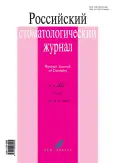Treatment of gum recession using SANS MOTS oil
- Authors: Lopatina N.V.1, Khaybullina R.R.1, Danilko K.V.1, Shangina O.R.1,2, Gerasimova L.P.1, Tukhvatullina D.N.1
-
Affiliations:
- Bashkir State Medical University
- All-Russian Center for Eye and Plastic Surgery
- Issue: Vol 26, No 6 (2022)
- Pages: 481-485
- Section: Experimental and Theoretical Investigations
- Submitted: 04.10.2022
- Accepted: 17.11.2022
- Published: 28.02.2023
- URL: https://rjdentistry.com/1728-2802/article/view/111159
- DOI: https://doi.org/10.17816/dent111159
- ID: 111159
Cite item
Abstract
RELEVANCE: An artificial gum recession defect was created in 50 Wistar rats. SANS MOTS oil containing marque blanche phytoconcentrate with phytosterols was applied to the defect area for 20 min. 5 times, with a 2-day interval.
AIM: To evaluate the effectiveness of the treatment method.
MATERIAL AND METHODS: An experimental gum recession model was created by mechanically excising periodontal tissues in a V-shape. Fifty white female rats were used as the model. Surgical intervention was performed on the lower jaw in the incisor area. The animals were divided into 2 groups depending on the planned treatment method. The control group consisted of 10 rats with healthy gums. The SANS MOTS oil was applied to the defect area for 20 min, 5 times, with an interval of 2 days in the other group. The effectiveness of the treatment was evaluated by the proposed method.
RESULTS: Complete restoration of the dentoalveolar papillae and regeneration of periodontal tissues occurred in the experimental gum recession area during the first 28 days. At the same time, the main group developed no signs of inflammation (hyperemia, edema, bleeding gums), which confirms the therapeutic effect of the SANS MOTS oil.
CONCLUSION: The SANS MOTS oil had a beneficial effect on gum recession. The decrease in the intensity and prevalence of gingival inflammation began on day 14. There were no signs of inflammation by day 28 after applying the oil. In addition, there was a noticeable increase in regeneration of the gingival margin by day 24 in the gum recession model, and complete restoration of the gingival papillae and no gum recession were noted by day 38.
Keywords
Full Text
About the authors
Natalya V. Lopatina
Bashkir State Medical University
Email: 89273065446@mail.ru
ORCID iD: 0000-0002-4547-3034
Postgraduate Student
Russian Federation, 3, Lenin street, Ufa, 450008Rasima R. Khaybullina
Bashkir State Medical University
Author for correspondence.
Email: rasimadiana@mail.ru
ORCID iD: 0000-0002-9839-3492
MD, Dr Sci. (Med.), Professor
Russian Federation, 3, Lenin street, Ufa, 450008Ksenia V. Danilko
Bashkir State Medical University
Email: kse-danilko@yandex.ru
ORCID iD: 0000-0002-4374-2923
Scopus Author ID: 16023913600
Cand. Sci. (Biol.), Senior Researcher
Russian Federation, 3, Lenin street, Ufa, 450008Olga R. Shangina
Bashkir State Medical University; All-Russian Center for Eye and Plastic Surgery
Email: alloolga@mail.ru
ORCID iD: 0000-0003-1686-1254
MD, Dr Sci. (Med.), Professor
Russian Federation, 3, Lenin street, Ufa, 450008; UfaLarisa P. Gerasimova
Bashkir State Medical University
Email: gerasimovalarisa@rambler.ru
ORCID iD: 0000-0002-1145-6500
MD, Dr Sci. (Med.), Professor
Russian Federation, 3, Lenin street, Ufa, 450008Damira N. Tukhvatullina
Bashkir State Medical University
Email: damirastom@yandex.ru
ORCID iD: 0000-0003-4166-2601
MD, Cand. Sci. (Med.), Associate Professor
Russian Federation, 3, Lenin street, Ufa, 450008References
- Almuratova AS. Gingival recession. Medicine and Ecology. 2018;(1):15–22. (In Russ).
- Durnovo EA, Bespalova NA, Shashurina SV. Comparative analysis of the clinical effectiveness of various methods for eliminating gingival recessions. Uspekhi Sovremennoy Nauki. 2016;9(3):174–181. (In Russ).
- Kostionova-Ovod IA, Trunin DA, Nesterov AM, Sadykov MI. Gingival biotype and methods of its assessment (literature review). Institut Stomatologii. 2020;(1):86–87. (In Russ).
- Rubnikovich SP, Volotovsky ID, Denisova YuL, et al. The use of cellular technologies in the treatment of patients with gingival recession. Medical Journal. 2019;(2):101–107. (In Russ).
- Ganzha IR, Modina TN, Khamadeeva AM. Gum recession. Diagnostics and methods of treatment. Samara: Sodruzhestvo; 2007. 84 p. (In Russ).
- Afonina E.S., Miklyaev S.V., Leonova O.M. Analysis of the prevalence of gum recession at 15–25 years of age. System Analysis and Management in Biomedical Systems. 2020;19(1):190–193. (In Russ). doi: 10.25987/VSTU.2020.19.1.027
- Zograbyan AG. Two-layer technique for eliminating gingival recession in combination with a wedge-shaped defect. Dental Implantology and Surgery. 2016;3(24):106–107. (In Russ).
- Vasenev EE, Alekhanova IF, Belichenko OA. The use of preparations based on hyaluronic acid in periodontology. Innovatsionnaya Nauka. 2016;(2-5):99–101. (In Russ).
- Orekhova L, Kudryavtseva T, Loboda E, Neizberg D. Causation of gingival recession. Antibacterial and antiinflammatory parts of complex treatment. Parodontologiya. 2017;22(4):20–23. (In Russ).
- Yusupova SS, Kostrigina ED, Skvortsova EN, et al. Modern methods of treating gingival recession. Modern Science: Actual Problems of Theory and Practice. Series: Natural and Technical Sciences. 2020;(11):214–219. (In Russ).
- Trunin DA, Nesterov AM, Sadykov MI, Kostionova-Ovod IA. A way to eliminate local recession of the gums. Ural Medical Journal. 2019;12(180):14–17. (In Russ).
- Shashurina SV. Sovershenstvovaniye metodov khirurgicheskogo lecheniya retsessiy desny [dissertation thesis]. Tver; 2017. 23 p. (In Russ).
Supplementary files








